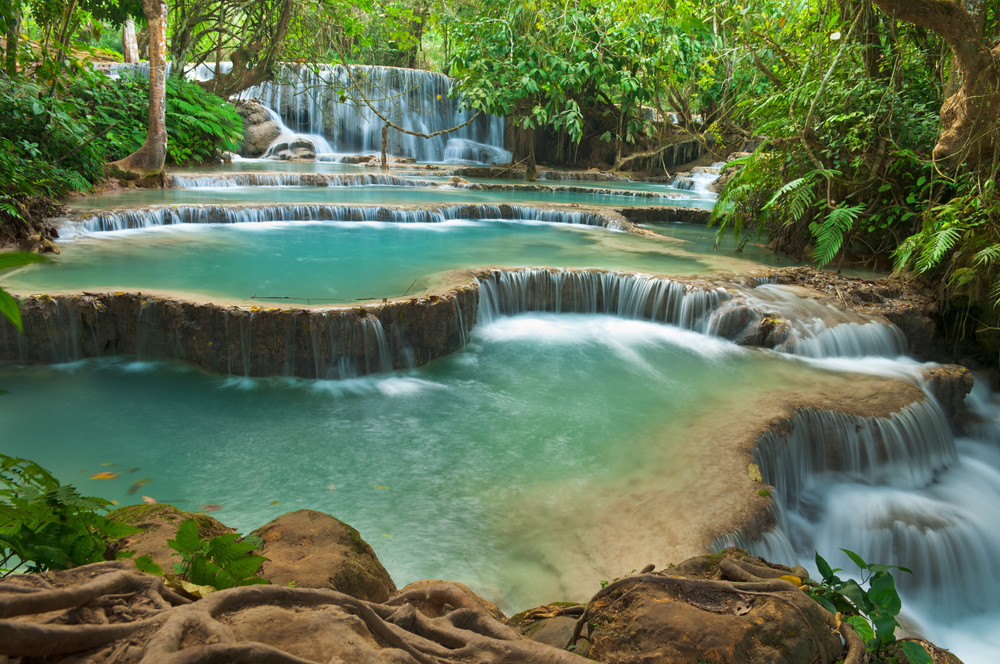
You might also like:
LAOS is something of a mystery to most travelers before they arrive; a sleepy country nestled amongst more well-known neighbors like Thailand, Vietnam and Cambodia.
Luang Prabang
Kuang Si Waterfalls, Luang Prabang. Pic: lkunl/Shutterstock
Luang Prabang is one of the most well-known travel stops in Laos, but that doesn’t mean you should write it off. The northern city is a UNESCO World Heritage Site, and offers respite from the hectic nature of the backpacking trail. You can visit old wats, or temples, to marvel at the elaborate art and appreciate the country’s spiritual culture. There are also traditional teak wooden houses to visit, including UNESCO-sponsored Heritage House, a stark contrast to the new buildings already being developed in Vientiane, the capital of this developing nation. When you’ve had enough of exploring the town, hop into a tuk-tuk and head to the Kuang Si waterfalls, which is favored by travelers and locals alike for swimming and frolicking in the water.
Plain of Jars

Plain of Jars, Phonsovan. Pic: Stanislav Fosenbauer/Shutterstock
Here you’ll have a chance to glimpse both ancient and more modern Laotian history. The Plain of Jars, which is strewn with massive stone…well, jars, is impressive and fascinating in that little is known about the purpose of the area. There are hundreds of jars at the three main sites alone, though more can be found at less well-known locations. According to Lonely Planet, the largest of the jars was said to be the cup of a mythical king and weighs six tons. Meanwhile, Australia’s The Age ran an article on seeking out the truth of the Plain of Jars. There are three sites that tourists can reach with reasonable ease, but it is important for travelers to remember that this is a remote area, with far fewer amenities than, say, Vientiane. You can also take tours of surrounding villages, going a little deeper into the countryside and observing the local way of life.
The 4,000 Islands

Si Phan Don. Pic: crossingtravel
It wouldn’t be a southeast Asian vacation if you didn’t spend at least some time by the water, and your opportunity in Laos comes in the form of the 4,000 Islands, or Si Phan Don. Lonely Planet recommends getting in on the kayaking action in this part of Laos, which you can do as an afternoon excursion or turn into a multi-day adventure. This will give you a chance to visit the islands at your own pace, stopping off whenever you feel the urge to lounge in the sun and do the lazy tourist thing. You may also get to spot a rare Irrawaddy dolphin – how many times in your life will you be able to say that?
Champasak Ruins

One of the ruins at Wat Phu in Champasak. Pic: Saylakham/Shutterstock
Don’t have time to make it across the border into Cambodia to see Angkor Wat? You can still get a view of the Khmer ruins by visiting Wat Phu, an ancient Khmer Hindu temple complex built in the 12th century. You can visit the ruins and a museum on the premises to learn more about the structure’s background and local history. Though a small town today, Champasak was once its own kingdom, making the ruins you’ll find here all the more haunting and significant. You can also enjoy great views of the Mekong River, which the town is built on, according to Matador Network. Though you’re sure to run into plenty of backpackers in this quiet, relaxed town, you’ll find it’s far less saturated with travelers than Angkor Wat or many sites in Thailand.
Vientiane

Wat Phra Keo in Vientiane
Though not as beautiful, or fun, as some other places in Laos, it’s usually worth spending at least a few days in a country’s capital, to get a sense of its history and development. Located on the Mekong River, Vientiane is clearly still a city in the midst of change, which makes it all the more reason to visit now. Traditional markets and temples contrast with massive building projects, tourist-friendly bars and other signs Laos is another up-and-coming destination in southeast Asia. Top sites to see include the COPE Centre exhibit on UXO and the legacy of cluster bombs in Laos, and the night market on the promenade on the banks of the Mekong.
Source: travelwireasia.com



